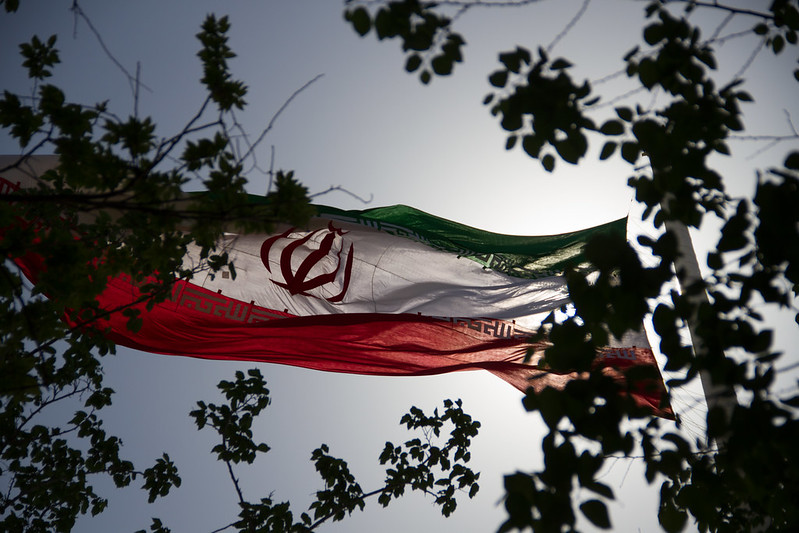Widespread protests erupted in the United States, as well as in some European countries, after the killing of George Floyd by police on May 25, 2020, in Minneapolis. Many politicians reacted and condemned the racist behavior of the police, but in the meantime, the reaction of Ali Khamenei, the Supreme Leader of the Islamic Republic since 1989, was noticeable.
“A policeman cold-bloodedly put his whole knee on the neck of a black man to kill him, and some other policemen watched and did nothing. This is a fact that has always been kept hidden, just as the sludge rises from the bottom of the pond and reveals itself,” Khamenei said in those days.
Khamenei’s remarks were met with a sharp reaction from Iranian Twitter users and were ridiculed by many. Because after the Islamic Revolution, many Iranians were imprisoned, executed, or forced to leave their homeland by the new regime. In recent years, police have repeatedly fired on people during street protests, and it was only last year about 1,500 people across the country were killed in public during protests against increasing the price of fuel.
A few days ago, on Saturday, October 24, 2020, a news item was reported on BBC Persian TV that caused great anger among Iranians. The news was related to Mehrdad Sepehri from Mashhad, who was publicly tied to a pole by the police and harassed with a shocker and pepper spray. According to witnesses, the torture lasted about 45 minutes. But that was not the end of the story.
Thousands of Twitter users reacted to the video, recalling Khamenei’s remarks about George Floyd and asking why such an incident had taken place in Iran, in a country in which he considers himself the leader. At the time of Floyd’s death, many pro-government forces held mourning ceremonies to express their opposition to US policies, but when it came to Sepehri, they considered his death insignificant.
“Any violation in any system against anyone can be prosecuted, but a small incident should not weaken the police,” said Ebrahim Raisi, the current Chief Justice of Iran.
By describing it as a “small incident”, he meant that police officers can basically allow themselves to kill someone after torture, instead of resolving the dispute. These days, we often hear such contradictory and ridiculous statements from the officials involved in this incident. “On the day of the incident, the victim had a fight with family members and neighbors,” said Ali Akbar Ahmadinejad, the Special Murder Investigator at the Mashhad Public and Revolutionary Prosecutor’s Office.
Another issue that has angered people is the presence of children and teenagers in the scene. The video shows that they were openly witnessing the torture of a man by the police, and some were laughing. No one intervened and none of the adults wanted to save the poor man. Who is responsible for the spread of violence in Iran?
Abdolkarim Lahiji, the president of the International Federation for Human Rights in 2013, believes that such violence perpetrated by the police or other institutions is a feature of the police state. In an interview with BBC Persian TV, he says that even if Mehrdad Sepehri was accused, he should not have been treated like this.
“Iran’s Code of Criminal Procedure states that the police are the officers of the judicial system of Iran, but now we can clearly see that it’s opposite and the judicial system is under the command of the IRGC (Islamic Revolutionary Guard Corps), the Ministry of Intelligence, and the police forces. They deal with the accused from the first minute, and then send the case to the court so that they can just stamp and finish everything. It is in such a system that the rights of individuals are simply ignored. When the police are not accountable for their actions, the scope of their activities goes beyond the victim and they allow themselves to reach out to their families or prevent the release of videos such as this one.”
This is true. Recently, in another incident, police arrested and detained a person who had filmed a officers hitting a young woman, not the assailants.
Mehrdad Sepehri had an argument with his wife that day, so the neighbors called the police to take action. Police forcibly removed him from the house, then handcuffed him and tied him to a pole. Apparently, the police had arrived by motorbike at the time, and it took about 45 minutes to an hour for the car to arrive. It was during this time that the police tortured Mehrdad in response to his cries.
Massoud, Mehrdad’s brother, in an interview with Iran International, a British-based Persian television station, said that his brother was alive when they put him in a police car. But along the way, he was tortured more severely by them and Mehrdad became lethargic. Then they called the emergency services, but before the ambulance reached Taleghani Hospital in Mashhad, Mehrdad died and his lifeless body was handed over.
When the officers put Mehrdad in the ambulance, they introduced him as an unknown person who had fallen on the street corner and they found him accidently. They said they were unaware of his address and family. After Massoud went to the hospital morgue, he recognized his brother’s body and saw signs of torture and wounds around his wrists, chest, neck and head. He then followed up and sent the body to a medical jurisprudence for a closer examination. There they told him Mehrdad was most likely suffocated by pepper spray. His lung was sampled and is currently under investigation.
It was right after this interview that the government pressured the Sepehri family not to interview with any media.
“They have been intimidated and warned to remain silent,” said Farin Assemi, a BBC Persian senior reporter. “Mehrdad Sepehri’s father’s and nephew’s cell phones were blocked and his brother was summoned to his workplace.” Right now, nobody knows anything about them.
Image credit: David Sandoz

